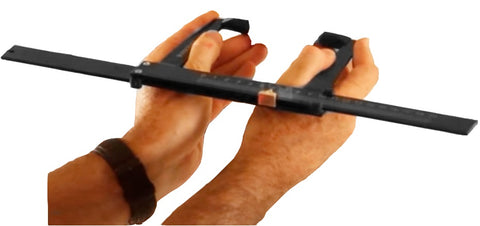An anthropometer or sliding caliper is used to measure diameters and lengths of different bones in the body. There are two types of anthropometers: small bone and large bone anthropometers, and depending on these different anthropometric measurements are made
What is a Small Bone Anthropometer Used For?
A small bone anthropometer is used to measure the diameters of the following measurements:
- Wrist (Bistyloid)
- Elbow (Humerus)
- Knee (Femoral)
- Ankle (Bimalleolar)
How Much does a Small Bone Anthropometer Cost?
A small anthropometer typically costs between $20 - $425 in the United States. Compare Small Bone Anthropometers
How to Use a Small Bone Anthropometer
Note: To effectively use a small anthropometer requires training with a certified instructor and supervised practice. The following instructions are just an introduction. You can learn more about ISAK anthropometric training courses here.
Before you start measuring, the first thing to consider is how to hold it. It should be taken with both hands, putting each index at the outer end of each branch and thumb on the inside of them, the middle fingers should be free as they are used to identify and locate the bones or anatomical points to measure, as follows : 
Basic anthropometric measurements performed with a small bone anthropometer are:
Wrist (Bistyloid) Diameter:The subject to be measured must have the arm in pronation. The styloid process of the radius and the ulna is taken as a reference, where each jaw of the anthropometer should be located at an angle of 45 °. |
 |
|
Elbow (humerus) Diameter:(or Biepicondyle of the humerus) the medial and lateral epicondyle are taken as reference. The anthropometer is positioned at 90 ° from the forearm, the jaws of the anthropometer are located at each epicondyle and the measurement is read. Note: the lateral epicondyle is slightly upward. |
 |
Knee (Femoral) Diameter:(or Biepicondylar of femur) The subject to be measured should be seated with the knees at a 90 ° angle. Identify the epicondyles and locate each jaw on each of them. The anthropometer should be 45 ° downward. |
|
Ankle (Bimalleolar):The subject to be measured should be seated with the knees at a 90 ° angle, with the feet flat on the floor. The anthropometrist should be in front and kneeling to identify the tibial (external) and malleolar fibula (internal) malleolar points and place each jaw of the anthropometer in each at a 45 ° angle. |
 |
Related Articles
More Articles about Anthropometry
International Buying Info
Shop our Amazon international stores for fast, easy, localized purchase: International Shipping From the USA InfoBecome a Distributor
Recommended Equipment
AnthroFlex Small Bone Anthropometer |
Cescorf Innovare Small Bone Anthropometer |
Cescorf Aluminum Small Bone Anthropometer |
 |
 |
 |

